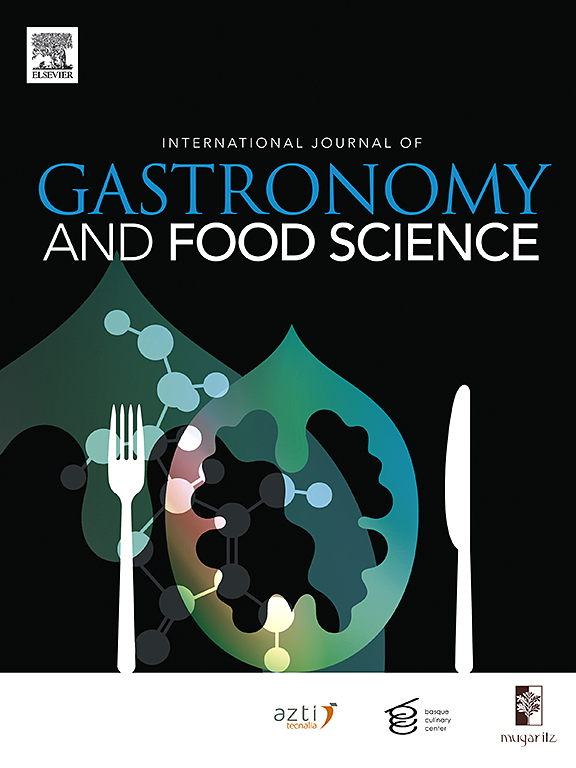巴西内陆地区公立学校菜单的多维评估
IF 3.6
2区 农林科学
Q2 FOOD SCIENCE & TECHNOLOGY
International Journal of Gastronomy and Food Science
Pub Date : 2025-06-12
DOI:10.1016/j.ijgfs.2025.101227
引用次数: 0
摘要
学校饮食环境在促进学生健康习惯方面发挥着至关重要的作用,学校菜单是确保提供营养均衡和可持续膳食的战略工具。本研究旨在通过考虑营养和环境方面的多维分析,对巴西Piauí州公立学校的菜单进行定性和定量评估。这项探索性研究分析了在2023学年收集的来自同一城市的15所公立学校的146份月度菜单。评估包括定性评估食品和营养安全协调质量指数(IQ COSAN),营养评估国家学校供餐计划菜单规划(PNAE Plan),以及衡量膳食对环境影响的碳足迹和水足迹指标。这些菜单的IQ COSAN平均得分为67.2,被归类为“需要改进”。膳食的平均能量含量为388.1千卡,其中碳水化合物占总能量的67.8%。牛肉是平均碳足迹最高的食物(4.2 kgCO2eq/kg),而大米的平均水足迹最高(127.5 L/kg)。饲粮多样性与水分之间存在相关性(r = 0.905, p <;0.001)和碳(r = 0.902, p <;碳足迹与碳水化合物在膳食中的参与呈负相关(r = - 0.795, p <;0.001)。需要改变菜单以满足营养建议并减少对环境的影响。使蛋白质来源多样化和重视区域食物等战略可有助于提供更营养均衡和可持续的菜单。本文章由计算机程序翻译,如有差异,请以英文原文为准。
Multidimensional assessment of menus of public schools in the interior of Brazil
The school food environment plays an essential role in promoting healthy habits among students, and school menus are a strategic tool to ensure the provision of nutritionally balanced and sustainable meals. This study aimed to qualitatively and quantitatively assess the menus of public schools in the state of Piauí, Brazil through a multidimensional analysis, considering nutritional and environmental aspects. This exploratory study analyzed 146 monthly menus from 15 state schools, all located in the same city, collected during the 2023 school year. The assessment included the Quality Index of the Food and Nutrition Security Coordination (IQ COSAN) for qualitative assessment, the Menu Planning of the National School Feeding Program (PNAE Plan) for nutritional evaluation, and carbon and water footprint indicators to measure the environmental impact of meals. The menus presented an average score of 67.2 in the IQ COSAN, classifying them as “in need of improvement”. The mean energy content of the meals was 388.1 kcal, with carbohydrates representing 67.8 % of the total energy. Beef was the food with the highest mean carbon footprint (4.2 kgCO2eq/kg), while rice had the highest mean water footprint (127.5 L/kg). There was a correlation between dietary diversity and the water (r = 0.905, p < 0.001) and carbon (r = 0.902, p < 0.001) footprints, and an inverse correlation between the carbon footprint and the participation of carbohydrates in the meals (r = −0.795, p < 0.001). Menus need to be changed to meet nutritional recommendations and reduce environmental impact. Strategies such as diversifying protein sources and valuing regional foods can contribute to more nutritionally balanced and sustainable menus.
求助全文
通过发布文献求助,成功后即可免费获取论文全文。
去求助
来源期刊

International Journal of Gastronomy and Food Science
Social Sciences-Cultural Studies
CiteScore
5.30
自引率
10.50%
发文量
170
审稿时长
45 days
期刊介绍:
International Journal of Gastronomy and Food Science is a peer-reviewed journal that explicitly focuses on the interface of food science and gastronomy. Articles focusing only on food science will not be considered. This journal equally encourages both scientists and chefs to publish original scientific papers, review articles and original culinary works. We seek articles with clear evidence of this interaction. From a scientific perspective, this publication aims to become the home for research from the whole community of food science and gastronomy.
IJGFS explores all aspects related to the growing field of the interaction of gastronomy and food science, in areas such as food chemistry, food technology and culinary techniques, food microbiology, genetics, sensory science, neuroscience, psychology, culinary concepts, culinary trends, and gastronomic experience (all the elements that contribute to the appreciation and enjoyment of the meal. Also relevant is research on science-based educational programs in gastronomy, anthropology, gastronomic history and food sociology. All these areas of knowledge are crucial to gastronomy, as they contribute to a better understanding of this broad term and its practical implications for science and society.
 求助内容:
求助内容: 应助结果提醒方式:
应助结果提醒方式:


